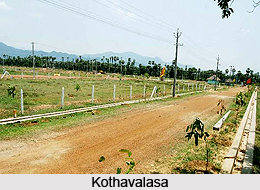 Kothavalasa has its location in the Vizianagaram district of Andhra Pradesh state.
Kothavalasa has its location in the Vizianagaram district of Andhra Pradesh state.
Location of Kothavalasa
Identification of its geographic location too acts as an identifying mark of the town concerned. Kothavalasa rises approximately at 17.9 degree North 83.2 degree East. It has an average height of 209 meters or 688 feet.
Demography of Kothavalasa
It was published in the year 2001 which depicts creation demographical facts like population status, literacy condition etc. Thus as per this report the total population of Kothavalasa has been measured to be 12,298. If one studies this report in details, few more facts also can be deciphered henceforth. Interestingly it is known that both male and female populace of Kothavalasa are in equal proportion. To be specific, male population constitutes 50 %, while population of females is also the same. In Kothavalasa, children who are below six years of age constitute 12 % of the total population.
Education of Kothavalasa
How much a town has accomplished growth is known if a person analyses its literacy status. If its literacy rate is high it assures its development in the true sense. Regarding Kothavalasa, it can be said that its average literacy rate is 69 %, which is even higher than that of Indian subcontinent. 59.5 % is the average literacy rates of India. Out of it , male literacy rate constitutes 76 %. However female literacy is less and thus constitutes 62 %. Added information about Kothavalasa only helps one to identify it in a better way. There Over twenty Roofing Tiles manufacturing units are built. The first one is the Andhra Tile Works, which was set up in the year 1957.
Villages in Kothavalasa
Apart from that , near about twenty eight revenue villages and also twenty five village panchayats are found in `Kothavalasa mandal`. These are as follows: Appannapalem (village and panchayat); Cheedivalasa (village and panchayat); Chinaraopalli (village and panchayat); Appannadorapalem (village and panchayat); Chinnipalem (village and panchayat); Chintalapalem (village and panchayat); Desapatrunipalem (village and panchayat); Devada (village and panchayat) ; Devaderu (village and panchayat); Ganisettypalem (village and panchayat) Gulivindala (village and panchayat) ;Gollalapalem (village and panchayat) ; Kantakapalli (village and panchayat) ;Mangalapalem (village and panchayat) ; Musiram (village and panchayat); Nimmalapalem (village and panchayat); Ramalingapuram (village and panchayat); Relli (village and panchayat) ; Santapalem (village and panchayat); Tummikapalli (village and panchayat) ; Uttarapalli (village and panchayat) ;Veerabhadrapuram (village and panchayat) ; Viyyampeta (village and panchayat).
Culture of Kothavalasa
Being an integral part of the district it is more than evident that people of Kothavalasa too strides into the district`s tradition. Hinduism is the main religion, which is practiced by wide number of people. Sankranti, Ugadi and Rama Navami, Maha Shivaratri, Diwali, Ganesh Chaturthi, Dasara Festival and Vijaya dasami are some of the major festivals, which people celebrate, in great splendour and vivacity.



















